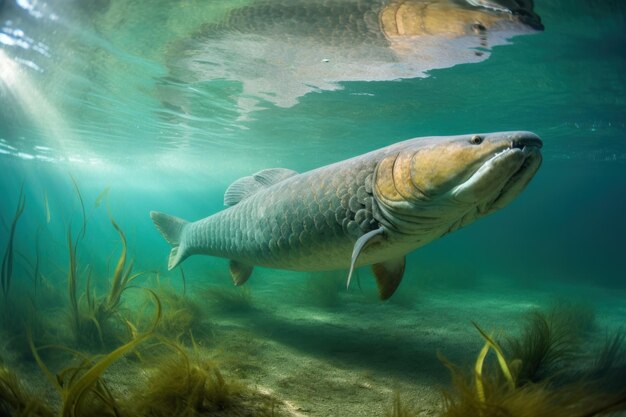A look at “Arapaima: The Gigantic Freshwater Fish” When it comes to fascinating creatures that inhabit our planet’s waters, few can rival the Arapaima. Known for its immense size and unique characteristics, this gigantic freshwater fish has captured the awe and curiosity of researchers and nature enthusiasts alike.
In this article, we will delve into the world of the Arapaima, exploring its habitat, physical attributes, behavior, and conservation efforts. Join us as we uncover the secrets of this magnificent creature that roams the rivers of South America.

The Origins of Arapaima
The Arapaima, scientifically known as Arapaima gigas, is a species of freshwater fish that traces its origins back millions of years. It belongs to the Osteoglossidae family, which includes other notable species like the Arowanas. Arapaima has a rich evolutionary history and is often referred to as a living fossil due to its resemblance to ancient fish species that lived during the Jurassic period.
Physical Characteristics
The Arapaima is renowned for its sheer size, making it one of the largest freshwater fish in the world. It can reach lengths of up to 10 feet (3 meters) and weigh over 400 pounds (180 kilograms). This fish possesses a streamlined body covered in large, bony scales, which provide protection against predators. Its coloration varies between individuals and can range from shades of olive-green to grayish-black.
Habitat and Distribution
Native to the Amazon River basin and its surrounding tributaries, the Arapaima inhabits the freshwater ecosystems of South America. It can be found in countries such as Brazil, Peru, and Colombia. Arapaima thrives in slow-moving rivers, flooded forests, and oxbow lakes. It has a unique adaptation that allows it to breathe atmospheric air using a specialized labyrinth organ, enabling the fish to survive in oxygen-deprived waters.
Feeding Habits
Arapaima is a voracious predator with a diverse diet. Its feeding habits vary depending on its size and age. Juvenile Arapaimas primarily feed on insects, small fish, and crustaceans. As they grow larger, their diet expands to include larger fish, small mammals, and even birds. With its large mouth and sharp teeth, the Arapaima is a formidable predator, capable of overpowering its prey with agility and speed.
Reproduction and Life Cycle
Arapaimas exhibit an interesting reproductive behavior. During the breeding season, males construct nests near the water’s surface using vegetation and their saliva as adhesive. Females lay thousands of eggs in these nests, and the males guard them fiercely until they hatch. Once the eggs hatch, the young Arapaimas have to fend for themselves, facing numerous challenges in their early stages of life.
Behavior and Adaptations
The Arapaima has developed several adaptations to survive in its environment. Its ability to breathe air allows it to inhabit oxygen-poor waters, where other fish would struggle to survive. Arapaimas are known to
Arapaimas are known to exhibit complex social behavior, often forming small groups or schools. These groups provide protection against predators and enhance their hunting efficiency. They are also capable of making distinctive booming sounds, believed to be a form of communication among individuals.
In addition to their remarkable adaptations for survival, Arapaimas possess an incredible ability to leap out of the water. This behavior, known as “porpoising,” allows them to catch prey located above the water’s surface. It’s a breathtaking spectacle to witness these massive fish gracefully propel themselves through the air.
Threats and Conservation
Despite their awe-inspiring presence, Arapaimas face significant threats to their survival. Habitat destruction, overfishing, and pollution are among the primary challenges they encounter. The demand for their meat and prized scales in the illegal wildlife trade further exacerbates their population decline.
Efforts are being made to protect and conserve Arapaima populations. Several conservation organizations are working alongside local communities to establish protected areas, enforce fishing regulations, and promote sustainable fishing practices. Education and awareness programs are also crucial in ensuring the long-term survival of these majestic creatures.
The Future of Arapaima
The future of Arapaima depends on the collective efforts of governments, conservationists, and communities. Strict enforcement of fishing regulations, sustainable management of their habitats, and the establishment of breeding and restocking programs are essential steps toward securing their survival. By recognizing the ecological importance of Arapaima and taking proactive measures, we can ensure the continued existence of this extraordinary species.
READ RELATED: Bryce Cass- Wiki, Age, Height, Net Worth, Girlfriend, Ethnicity
Arapaima Fun Facts for Kids
Sure! Here are some fun facts about Arapaima that kids would enjoy:
-
Gigantic Size: Arapaimas are one of the largest freshwater fish in the world, often reaching lengths of up to 10 feet (3 meters) and weighing over 400 pounds (180 kilograms). That’s like having a fish as long as a small car!
-
Ancient Fish: Arapaimas are considered living fossils because they have been around for millions of years. They have changed very little in appearance since the time of the dinosaurs.
-
Breathing Air: Unlike most fish that breathe through gills, Arapaimas have a special organ called a labyrinth that allows them to take in oxygen from the air. This adaptation helps them survive in oxygen-deprived waters.
-
Fantastic Leapers: Arapaimas have an amazing ability to leap out of the water. They can jump several feet high to catch prey like insects and birds that are perched above the water’s surface. It’s like seeing a fish fly!
-
Family Guardians: When Arapaimas lay their eggs, it’s the male fish that takes care of them. The male builds a nest and guards the eggs until they hatch, ensuring their safety from predators.
-
Master Predators: Arapaimas are skilled hunters. Their diet includes small fish, insects, crustaceans, and even small mammals and birds. With their sharp teeth and large mouths, they are excellent at catching their prey.
-
Social Swimmers: Arapaimas often swim in small groups called schools. Swimming together helps them protect themselves from predators and makes hunting more effective.
-
Booming Communicators: Arapaimas have a unique way of communicating. They can produce booming sounds, which are believed to be a way for them to talk to each other. It’s like they have their own underwater language!
-
Vulnerable Species: Unfortunately, Arapaimas are facing threats to their survival. Habitat destruction, overfishing, and pollution are endangering their populations. We need to protect these incredible fish and their homes.
-
Conservation Heroes: People around the world are working hard to save the Arapaimas. Conservation organizations and local communities are creating protected areas, promoting sustainable fishing practices, and raising awareness about the importance of these magnificent creatures.
Conclusion
In conclusion, the Arapaima is a captivating freshwater fish that captures our imagination with its gigantic size and unique adaptations. From its origins as a living fossil to its ability to breathe air and leap out of the water, the Arapaima showcases the wonders of nature. However, the challenges it faces underscore the need for conservation efforts to protect this remarkable species and its fragile habitat. Let us appreciate and safeguard the Arapaima, ensuring that future generations can marvel at its magnificence.
See Also | South American Tapir: The Amazon’s Large Herbivore
FAQs
A: Arapaimas are generally not dangerous to humans. They are shy and tend to avoid interactions with people.
A: Due to their large size and specific habitat requirements, it is not recommended to keep Arapaimas in home aquariums.
A: Arapaimas can live for several decades, with some individuals reaching ages of over 20 years.
A: Arapaimas are considered vulnerable to extinction due to habitat loss and overfishing.
A: While adult Arapaimas have few natural predators, their eggs and young are vulnerable to predation by other fish and birds.





